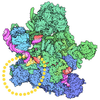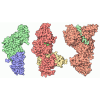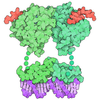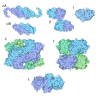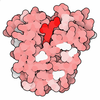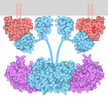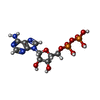+ データを開く
データを開く
- 基本情報
基本情報
| 登録情報 | データベース: PDB / ID: 9kmr | |||||||||||||||||||||
|---|---|---|---|---|---|---|---|---|---|---|---|---|---|---|---|---|---|---|---|---|---|---|
| タイトル | Human Hsp90-PINK1 complex | |||||||||||||||||||||
 要素 要素 |
| |||||||||||||||||||||
 キーワード キーワード | CHAPERONE / Hsp90 / PINK1 / CYTOSOLIC PROTEIN | |||||||||||||||||||||
| 機能・相同性 |  機能・相同性情報 機能・相同性情報positive regulation of synaptic transmission, dopaminergic / positive regulation of free ubiquitin chain polymerization / positive regulation of cristae formation / regulation of protein targeting to mitochondrion / mitochondrion to lysosome vesicle-mediated transport / maintenance of protein location in mitochondrion / establishment of protein localization to mitochondrion / protein kinase B binding / cellular response to hydrogen sulfide / Lewy body ...positive regulation of synaptic transmission, dopaminergic / positive regulation of free ubiquitin chain polymerization / positive regulation of cristae formation / regulation of protein targeting to mitochondrion / mitochondrion to lysosome vesicle-mediated transport / maintenance of protein location in mitochondrion / establishment of protein localization to mitochondrion / protein kinase B binding / cellular response to hydrogen sulfide / Lewy body / regulation of autophagy of mitochondrion / regulation of synaptic vesicle transport / TORC2 signaling / negative regulation of hypoxia-induced intrinsic apoptotic signaling pathway / positive regulation of mitochondrial electron transport, NADH to ubiquinone / regulation of hydrogen peroxide metabolic process / regulation of oxidative phosphorylation / negative regulation of hydrogen peroxide-induced neuron intrinsic apoptotic signaling pathway / C3HC4-type RING finger domain binding / regulation of cellular response to oxidative stress / dopamine secretion / negative regulation of autophagosome assembly / positive regulation of dopamine secretion / autophagy of mitochondrion / positive regulation of type 2 mitophagy / cellular response to toxic substance / negative regulation of oxidative stress-induced neuron intrinsic apoptotic signaling pathway / regulation of mitochondrion organization / negative regulation of JNK cascade / positive regulation of ubiquitin-protein transferase activity / positive regulation of protein targeting to mitochondrion / negative regulation of intrinsic apoptotic signaling pathway in response to hydrogen peroxide / regulation of reactive oxygen species metabolic process / peptidase activator activity / sperm mitochondrial sheath / sulfonylurea receptor binding / dATP binding / CTP binding / positive regulation of protein polymerization / Scavenging by Class F Receptors / astrocyte projection / vRNP Assembly / UTP binding / positive regulation of mitochondrial fission / negative regulation of macroautophagy / sperm plasma membrane / chaperone-mediated autophagy / negative regulation of mitophagy / Rho GDP-dissociation inhibitor binding / Respiratory syncytial virus genome replication / telomerase holoenzyme complex assembly / mitochondrial transport / Uptake and function of diphtheria toxin / Drug-mediated inhibition of ERBB2 signaling / Resistance of ERBB2 KD mutants to trastuzumab / Resistance of ERBB2 KD mutants to sapitinib / Resistance of ERBB2 KD mutants to tesevatinib / Resistance of ERBB2 KD mutants to neratinib / Resistance of ERBB2 KD mutants to osimertinib / Resistance of ERBB2 KD mutants to afatinib / Resistance of ERBB2 KD mutants to AEE788 / Resistance of ERBB2 KD mutants to lapatinib / Drug resistance in ERBB2 TMD/JMD mutants / FOXO-mediated transcription of cell death genes / negative regulation of intrinsic apoptotic signaling pathway / protein import into mitochondrial matrix / dendritic growth cone / TPR domain binding / positive regulation of release of cytochrome c from mitochondria / PIWI-interacting RNA (piRNA) biogenesis / Assembly and release of respiratory syncytial virus (RSV) virions / non-chaperonin molecular chaperone ATPase / positive regulation of ATP biosynthetic process / negative regulation of reactive oxygen species metabolic process / hemopoiesis / positive regulation of macroautophagy / protein unfolding / Sema3A PAK dependent Axon repulsion / regulation of protein ubiquitination / positive regulation of cell size / HSF1-dependent transactivation / response to unfolded protein / enzyme-substrate adaptor activity / skeletal muscle contraction / negative regulation of mitochondrial fission / HSF1 activation / regulation of protein-containing complex assembly / telomere maintenance via telomerase / Attenuation phase / chaperone-mediated protein complex assembly / axonal growth cone / neurofibrillary tangle assembly / regulation of postsynaptic membrane neurotransmitter receptor levels / RHOBTB2 GTPase cycle / mitophagy / positive regulation of lamellipodium assembly / nitric oxide metabolic process / eNOS activation / positive regulation of defense response to virus by host / DNA polymerase binding 類似検索 - 分子機能 | |||||||||||||||||||||
| 生物種 |  Homo sapiens (ヒト) Homo sapiens (ヒト) | |||||||||||||||||||||
| 手法 | 電子顕微鏡法 / 単粒子再構成法 / クライオ電子顕微鏡法 / 解像度: 2.98 Å | |||||||||||||||||||||
 データ登録者 データ登録者 | Tian, X.Y. / Su, J.Y. | |||||||||||||||||||||
| 資金援助 |  中国, 1件 中国, 1件
| |||||||||||||||||||||
 引用 引用 |  ジャーナル: To Be Published ジャーナル: To Be Publishedタイトル: Human Hsp90-PINK1 complex 著者: Tian, X.Y. / Su, J.Y. | |||||||||||||||||||||
| 履歴 |
|
- 構造の表示
構造の表示
| 構造ビューア | 分子:  Molmil Molmil Jmol/JSmol Jmol/JSmol |
|---|
- ダウンロードとリンク
ダウンロードとリンク
- ダウンロード
ダウンロード
| PDBx/mmCIF形式 |  9kmr.cif.gz 9kmr.cif.gz | 299.4 KB | 表示 |  PDBx/mmCIF形式 PDBx/mmCIF形式 |
|---|---|---|---|---|
| PDB形式 |  pdb9kmr.ent.gz pdb9kmr.ent.gz | 236 KB | 表示 |  PDB形式 PDB形式 |
| PDBx/mmJSON形式 |  9kmr.json.gz 9kmr.json.gz | ツリー表示 |  PDBx/mmJSON形式 PDBx/mmJSON形式 | |
| その他 |  その他のダウンロード その他のダウンロード |
-検証レポート
| 文書・要旨 |  9kmr_validation.pdf.gz 9kmr_validation.pdf.gz | 1.4 MB | 表示 |  wwPDB検証レポート wwPDB検証レポート |
|---|---|---|---|---|
| 文書・詳細版 |  9kmr_full_validation.pdf.gz 9kmr_full_validation.pdf.gz | 1.4 MB | 表示 | |
| XML形式データ |  9kmr_validation.xml.gz 9kmr_validation.xml.gz | 54.2 KB | 表示 | |
| CIF形式データ |  9kmr_validation.cif.gz 9kmr_validation.cif.gz | 81.2 KB | 表示 | |
| アーカイブディレクトリ |  https://data.pdbj.org/pub/pdb/validation_reports/km/9kmr https://data.pdbj.org/pub/pdb/validation_reports/km/9kmr ftp://data.pdbj.org/pub/pdb/validation_reports/km/9kmr ftp://data.pdbj.org/pub/pdb/validation_reports/km/9kmr | HTTPS FTP |
-関連構造データ
| 関連構造データ |  62442MC M: このデータのモデリングに利用したマップデータ C: 同じ文献を引用 ( |
|---|---|
| 類似構造データ | 類似検索 - 機能・相同性  F&H 検索 F&H 検索 |
- リンク
リンク
- 集合体
集合体
| 登録構造単位 | 
|
|---|---|
| 1 |
|
- 要素
要素
| #1: タンパク質 | 分子量: 84781.727 Da / 分子数: 2 / 由来タイプ: 天然 / 由来: (天然)  Homo sapiens (ヒト) Homo sapiens (ヒト)参照: UniProt: P07900, non-chaperonin molecular chaperone ATPase #2: タンパク質 | | 分子量: 62842.863 Da / 分子数: 1 / 由来タイプ: 組換発現 / 由来: (組換発現)  Homo sapiens (ヒト) / 遺伝子: PINK1 / 発現宿主: Homo sapiens (ヒト) / 遺伝子: PINK1 / 発現宿主:  Homo sapiens (ヒト) Homo sapiens (ヒト)参照: UniProt: Q9BXM7, non-specific serine/threonine protein kinase #3: 化合物 | 研究の焦点であるリガンドがあるか | Y | Has protein modification | N | |
|---|
-実験情報
-実験
| 実験 | 手法: 電子顕微鏡法 |
|---|---|
| EM実験 | 試料の集合状態: PARTICLE / 3次元再構成法: 単粒子再構成法 |
- 試料調製
試料調製
| 構成要素 | 名称: human Hsp90 and PINK1 complex / タイプ: COMPLEX / Entity ID: #1-#2 / 由来: RECOMBINANT |
|---|---|
| 分子量 | 値: 0.23 MDa / 実験値: NO |
| 由来(天然) | 生物種:  Homo sapiens (ヒト) Homo sapiens (ヒト) |
| 由来(組換発現) | 生物種:  Homo sapiens (ヒト) Homo sapiens (ヒト) |
| 緩衝液 | pH: 7.4 |
| 試料 | 包埋: NO / シャドウイング: NO / 染色: NO / 凍結: YES |
| 試料支持 | グリッドの材料: GOLD / グリッドのサイズ: 400 divisions/in. |
| 急速凍結 | 凍結剤: ETHANE / 湿度: 100 % |
- 電子顕微鏡撮影
電子顕微鏡撮影
| 実験機器 |  モデル: Titan Krios / 画像提供: FEI Company |
|---|---|
| 顕微鏡 | モデル: TFS KRIOS |
| 電子銃 | 電子線源:  FIELD EMISSION GUN / 加速電圧: 300 kV / 照射モード: FLOOD BEAM FIELD EMISSION GUN / 加速電圧: 300 kV / 照射モード: FLOOD BEAM |
| 電子レンズ | モード: BRIGHT FIELD / 最大 デフォーカス(公称値): 1800 nm / 最小 デフォーカス(公称値): 1300 nm |
| 撮影 | 電子線照射量: 50 e/Å2 フィルム・検出器のモデル: GATAN K2 SUMMIT (4k x 4k) |
- 解析
解析
| EMソフトウェア | 名称: PHENIX / カテゴリ: モデル精密化 | ||||||||||||||||||||||||
|---|---|---|---|---|---|---|---|---|---|---|---|---|---|---|---|---|---|---|---|---|---|---|---|---|---|
| CTF補正 | タイプ: PHASE FLIPPING ONLY | ||||||||||||||||||||||||
| 3次元再構成 | 解像度: 2.98 Å / 解像度の算出法: FSC 0.143 CUT-OFF / 粒子像の数: 757800 / 対称性のタイプ: POINT | ||||||||||||||||||||||||
| 精密化 | 立体化学のターゲット値: REAL-SPACE (WEIGHTED MAP SUM AT ATOM CENTERS) | ||||||||||||||||||||||||
| 拘束条件 |
|
 ムービー
ムービー コントローラー
コントローラー



 PDBj
PDBj





